2016 HYUNDAI IX35 sensor
[x] Cancel search: sensorPage 7 of 550

Introduction21This Owners Manual is designed to help
vehicle users derive the greatest possi-
ble amount of enjoyment and satisfaction
from driving the HYUNDAI vehicle. It is
strongly recommended that the entire
manual is read in order that all of the fea-
tures, safety systems and maintenance
requirements are understood.
To minimise the RISK of death or injury,
the "WARNING" and "CAUTION" state-
ments must be read and understood
before operating the vehicle.
Illustrations are used throughout the
manual to complement written descrip-
tions intended to best explain how to
enjoy using the vehicle.
Reading this manual will assist the vehi-
cle user to learn about and understand
the features, important safety informa-
tion, and driving recommendations.
The general layout of the manual is pro-
vided in the Table of Contents. The index
has an alphabetical listing of all the infor-
mation contained in the manual. The
manual has eight sections plus an index.
Each section begins with a brief list of
contents to easily identify at a glance if
that section contains the information
being sought."WARNING", "CAUTION", and "NOTICE"
information is provided to enhance the
personal safety of the vehicle user. This
information must be carefully read and
followed.
✽ ✽
NOTICEA NOTICE indicates interesting or help-
ful information is being provided.
Petrol engineUnleadedFor the optimal vehicle performance, we
recommend you use unleaded petrol
which has an octane rating of RON
(Research Octane Number) 95 / AKI
(Anti Knock Index) 91 or higher. (Do not
use methanol blended fuels.)
You may use unleaded petrol with an
octane rating of RON 91~94/AKI 87~90
but it may result in slight performance
reduction of the vehicle.
HOW TO USE THIS MANUAL FUEL REQUIREMENTS
WARNING
A WARNING indicates a situation in
which harm, serious bodily injury or
death could result if the warning is
ignored.
CAUTION
A CAUTION indicates a situation in
which damage to your vehicle couldresult if the caution is ignored.
CAUTION
NEVER USE LEADED FUEL. The use of leaded fuel is detrimental tothe catalytic converter and will damage the engine control sys-tem’s oxygen sensor and affectemission control.
Never add any fuel system cleaningagents to the fuel tank other thanwhat has been specified. (We rec- ommend that you consult aHYUNDAI authorised repairer for details.)
EL(FL) UK 1.QXP 12/16/2014 8:50 PM Page 2
Page 45 of 550
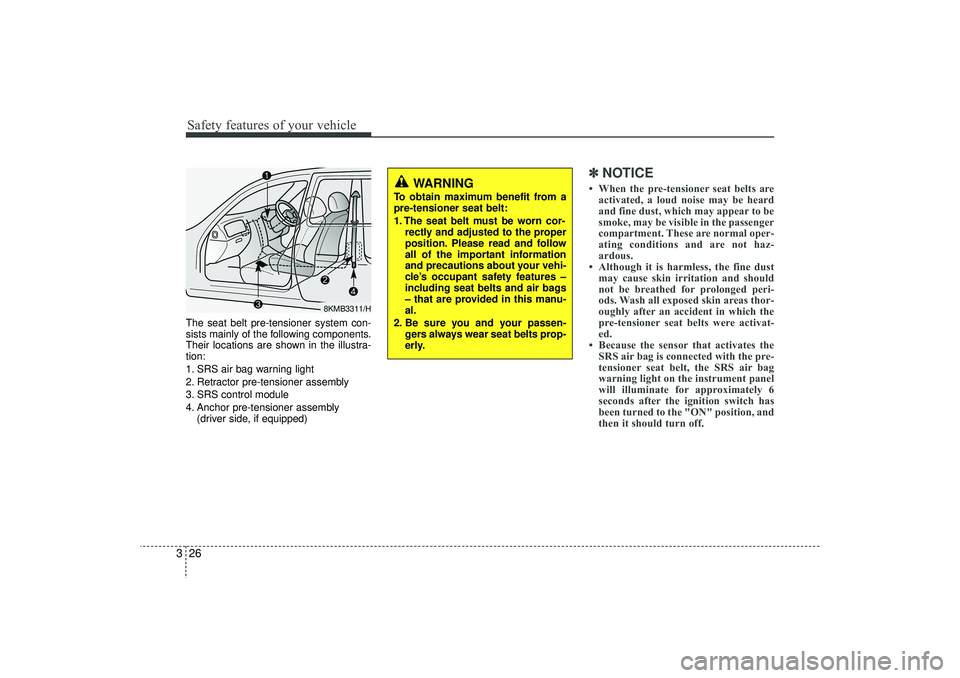
Safety features of your vehicle26
3The seat belt pre-tensioner system con-
sists mainly of the following components.
Their locations are shown in the illustra-
tion:
1. SRS air bag warning light
2. Retractor pre-tensioner assembly
3. SRS control module
4. Anchor pre-tensioner assembly
(driver side, if equipped)
✽ ✽NOTICE• When the pre-tensioner seat belts are
activated, a loud noise may be heard
and fine dust, which may appear to be
smoke, may be visible in the passenger
compartment. These are normal oper-
ating conditions and are not haz-
ardous.
• Although it is harmless, the fine dust may cause skin irritation and should
not be breathed for prolonged peri-
ods. Wash all exposed skin areas thor-
oughly after an accident in which the
pre-tensioner seat belts were activat-
ed.
• Because the sensor that activates the SRS air bag is connected with the pre-
tensioner seat belt, the SRS air bag
warning light on the instrument panel
will illuminate for approximately 6
seconds after the ignition switch has
been turned to the "ON" position, and
then it should turn off.
8KMB3311/H
WARNING
To obtain maximum benefit from a
pre-tensioner seat belt:
1. The seat belt must be worn cor-
rectly and adjusted to the proper
position. Please read and follow
all of the important information
and precautions about your vehi-
cle’s occupant safety features –
including seat belts and air bags
– that are provided in this manu-
al.
2. Be sure you and your passen- gers always wear seat belts prop-
erly.
EL(FL) UK 3.QXP 12/16/2014 8:56 PM Page 26
Page 63 of 550
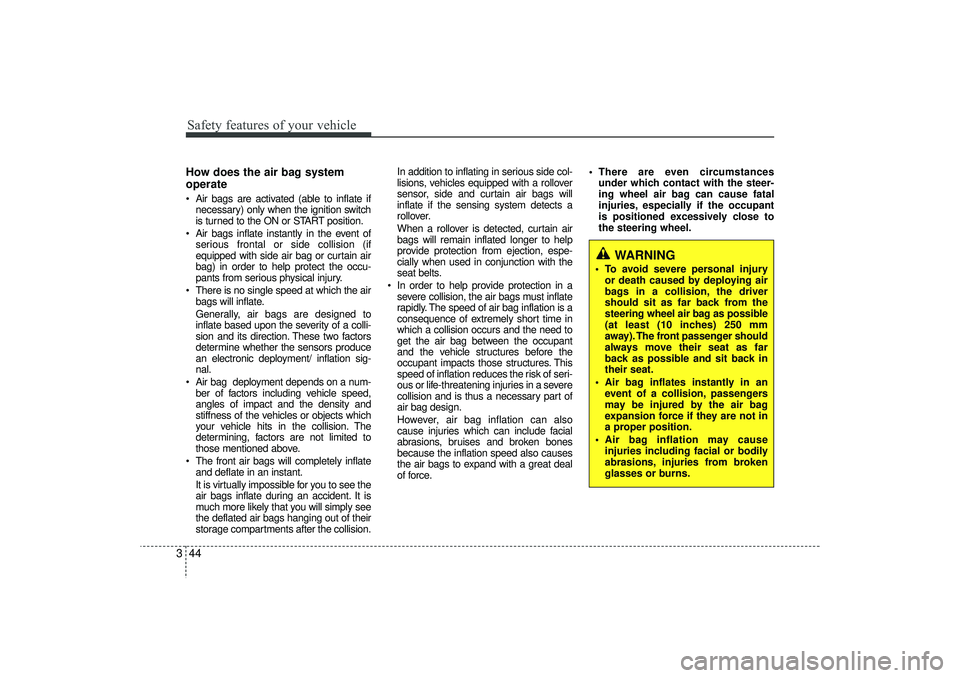
Safety features of your vehicle44
3How does the air bag system
operate Air bags are activated (able to inflate if
necessary) only when the ignition switch
is turned to the ON or START position.
Air bags inflate instantly in the event of serious frontal or side collision (if
equipped with side air bag or curtain air
bag) in order to help protect the occu-
pants from serious physical injury.
There is no single speed at which the air bags will inflate.
Generally, air bags are designed to
inflate based upon the severity of a colli-
sion and its direction. These two factors
determine whether the sensors produce
an electronic deployment/ inflation sig-
nal.
Air bag deployment depends on a num- ber of factors including vehicle speed,
angles of impact and the density and
stiffness of the vehicles or objects which
your vehicle hits in the collision. The
determining, factors are not limited to
those mentioned above.
The front air bags will completely inflate and deflate in an instant.
It is virtually impossible for you to see the
air bags inflate during an accident. It is
much more likely that you will simply see
the deflated air bags hanging out of their
storage compartments after the collision. In addition to inflating in serious side col-
lisions, vehicles equipped with a rollover
sensor, side and curtain air bags will
inflate if the sensing system detects a
rollover.
When a rollover is detected, curtain air
bags will remain inflated longer to help
provide protection from ejection, espe-
cially when used in conjunction with the
seat belts.
In order to help provide protection in a severe collision, the air bags must inflate
rapidly. The speed of air bag inflation is a
consequence of extremely short time in
which a collision occurs and the need to
get the air bag between the occupant
and the vehicle structures before the
occupant impacts those structures. This
speed of inflation reduces the risk of seri-
ous or life-threatening injuries in a severe
collision and is thus a necessary part of
air bag design.
However, air bag inflation can also
cause injuries which can include facial
abrasions, bruises and broken bones
because the inflation speed also causes
the air bags to expand with a great deal
of force. There are even circumstances
under which contact with the steer-
ing wheel air bag can cause fatal
injuries, especially if the occupant
is positioned excessively close to
the steering wheel.
WARNING
To avoid severe personal injuryor death caused by deploying air
bags in a collision, the driver
should sit as far back from the
steering wheel air bag as possible
(at least (10 inches) 250 mm
away). The front passenger should
always move their seat as far
back as possible and sit back in
their seat.
Air bag inflates instantly in an event of a collision, passengers
may be injured by the air bag
expansion force if they are not in
a proper position.
Air bag inflation may cause injuries including facial or bodily
abrasions, injuries from broken
glasses or burns.
EL(FL) UK 3.QXP 12/16/2014 8:56 PM Page 44
Page 67 of 550
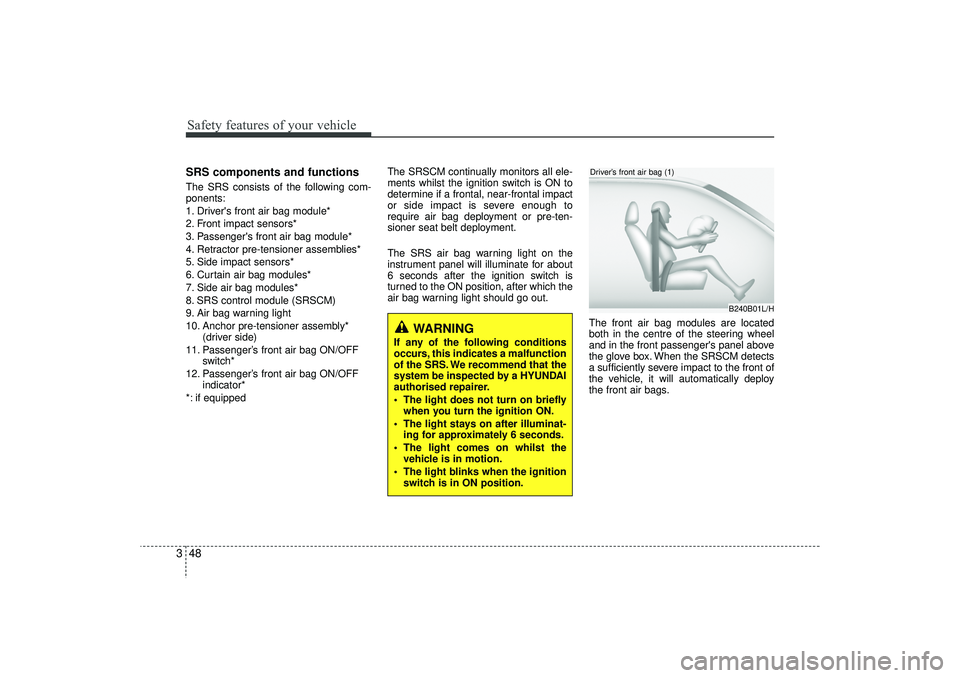
Safety features of your vehicle48
3SRS components and functionsThe SRS consists of the following com-
ponents:
1. Driver's front air bag module*
2. Front impact sensors*
3. Passenger's front air bag module*
4. Retractor pre-tensioner assemblies*
5. Side impact sensors*
6. Curtain air bag modules*
7. Side air bag modules*
8. SRS control module (SRSCM)
9. Air bag warning light
10. Anchor pre-tensioner assembly*
(driver side)
11. Passenger’s front air bag ON/OFF switch*
12. Passenger’s front air bag ON/OFF indicator*
*: if equipped The SRSCM continually monitors all ele-
ments whilst the ignition switch is ON to
determine if a frontal, near-frontal impact
or side impact is severe enough to
require air bag deployment or pre-ten-
sioner seat belt deployment.
The SRS air bag warning light on the
instrument panel will illuminate for about
6 seconds after the ignition switch is
turned to the ON position, after which the
air bag warning light should go out.
The front air bag modules are located
both in the centre of the steering wheel
and in the front passenger's panel above
the glove box. When the SRSCM detects
a sufficiently severe impact to the front of
the vehicle, it will automatically deploy
the front air bags.
WARNING
If any of the following conditions
occurs, this indicates a malfunction
of the SRS. We recommend that the
system be inspected by a HYUNDAI
authorised repairer.
The light does not turn on brieflywhen you turn the ignition ON.
The light stays on after illuminat- ing for approximately 6 seconds.
The light comes on whilst the vehicle is in motion.
The light blinks when the ignition switch is in ON position.
B240B01L/H
Driver’s front air bag (1)
EL(FL) UK 3.QXP 12/16/2014 8:56 PM Page 48
Page 75 of 550
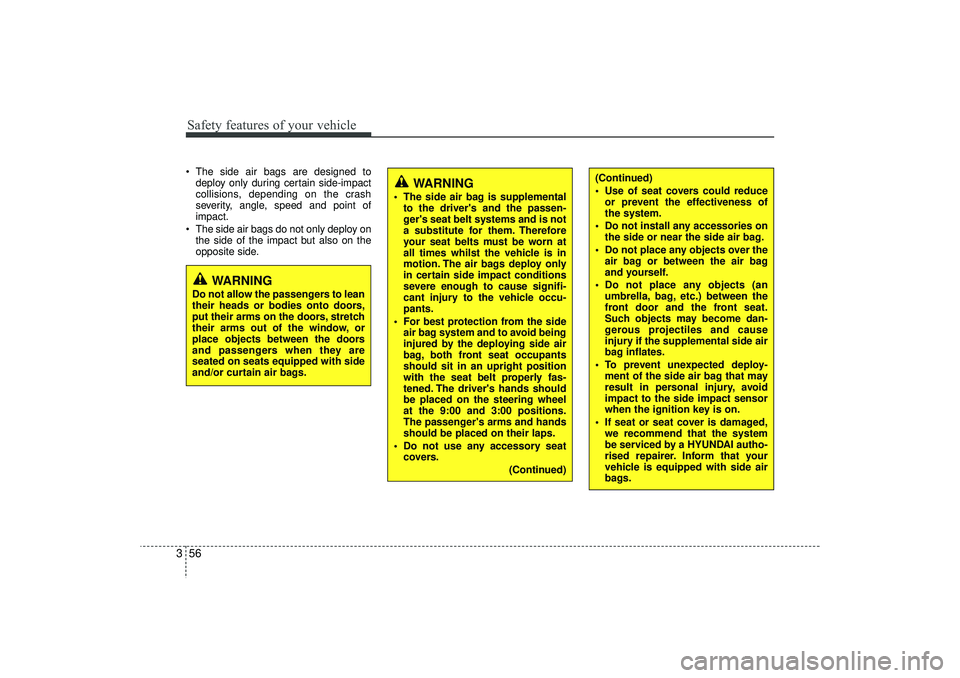
Safety features of your vehicle56
3 The side air bags are designed to
deploy only during certain side-impact
collisions, depending on the crash
severity, angle, speed and point of
impact.
The side air bags do not only deploy on the side of the impact but also on the
opposite side.
(Continued)
Use of seat covers could reduceor prevent the effectiveness of
the system.
Do not install any accessories on the side or near the side air bag.
Do not place any objects over the air bag or between the air bag
and yourself.
Do not place any objects (an umbrella, bag, etc.) between the
front door and the front seat.
Such objects may become dan-
gerous projectiles and cause
injury if the supplemental side air
bag inflates.
To prevent unexpected deploy- ment of the side air bag that may
result in personal injury, avoid
impact to the side impact sensor
when the ignition key is on.
If seat or seat cover is damaged, we recommend that the system
be serviced by a HYUNDAI autho-
rised repairer. Inform that your
vehicle is equipped with side air
bags.
WARNING
The side air bag is supplementalto the driver's and the passen-
ger's seat belt systems and is not
a substitute for them. Therefore
your seat belts must be worn at
all times whilst the vehicle is in
motion. The air bags deploy only
in certain side impact conditions
severe enough to cause signifi-
cant injury to the vehicle occu-
pants.
For best protection from the side air bag system and to avoid being
injured by the deploying side air
bag, both front seat occupants
should sit in an upright position
with the seat belt properly fas-
tened. The driver's hands should
be placed on the steering wheel
at the 9:00 and 3:00 positions.
The passenger's arms and hands
should be placed on their laps.
Do not use any accessory seat covers.
(Continued)
WARNING
Do not allow the passengers to lean
their heads or bodies onto doors,
put their arms on the doors, stretch
their arms out of the window, or
place objects between the doors
and passengers when they are
seated on seats equipped with side
and/or curtain air bags.
EL(FL) UK 3.QXP 12/16/2014 8:56 PM Page 56
Page 76 of 550
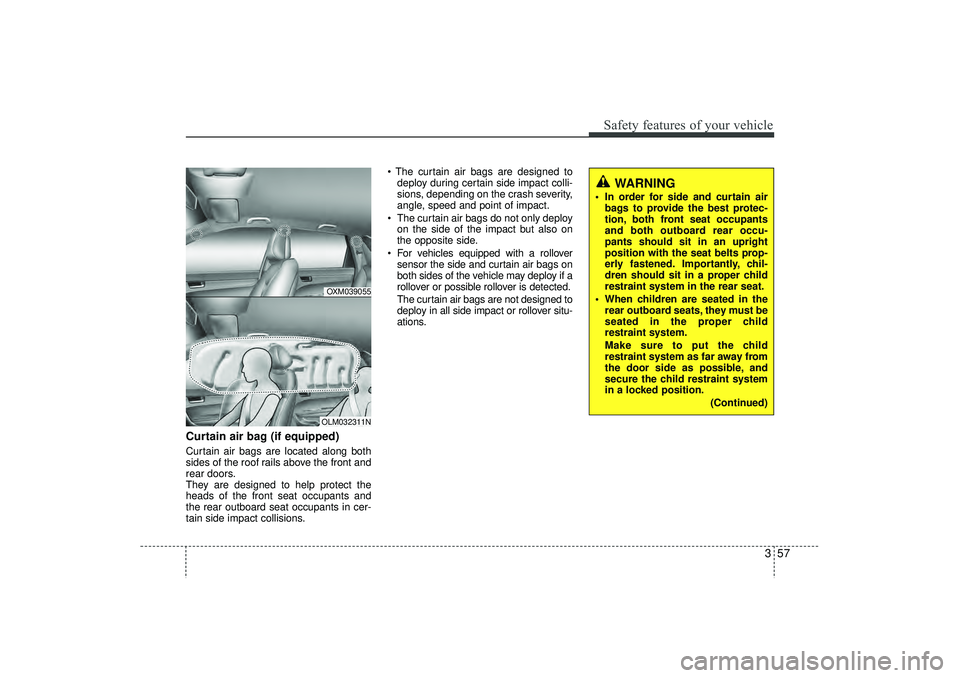
357
Safety features of your vehicle
Curtain air bag (if equipped)Curtain air bags are located along both
sides of the roof rails above the front and
rear doors.
They are designed to help protect the
heads of the front seat occupants and
the rear outboard seat occupants in cer-
tain side impact collisions. The curtain air bags are designed to
deploy during certain side impact colli-
sions, depending on the crash severity,
angle, speed and point of impact.
The curtain air bags do not only deploy on the side of the impact but also on
the opposite side.
For vehicles equipped with a rollover sensor the side and curtain air bags on
both sides of the vehicle may deploy if a
rollover or possible rollover is detected.
The curtain air bags are not designed to
deploy in all side impact or rollover situ-
ations.
WARNING
In order for side and curtain airbags to provide the best protec-
tion, both front seat occupants
and both outboard rear occu-
pants should sit in an upright
position with the seat belts prop-
erly fastened. Importantly, chil-
dren should sit in a proper child
restraint system in the rear seat.
When children are seated in the rear outboard seats, they must be
seated in the proper child
restraint system.
Make sure to put the child
restraint system as far away from
the door side as possible, and
secure the child restraint system
in a locked position.
(Continued)
OXM039055OLM032311N
EL(FL) UK 3.QXP 12/16/2014 8:56 PM Page 57
Page 78 of 550
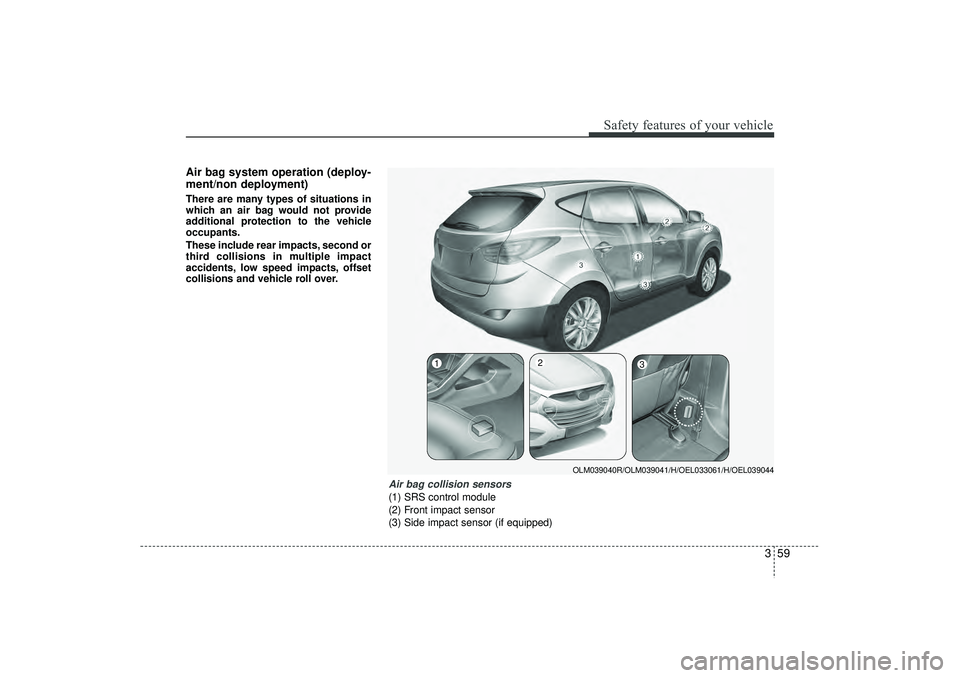
359
Safety features of your vehicle
Air bag system operation (deploy-
ment/non deployment)There are many types of situations in
which an air bag would not provide
additional protection to the vehicle
occupants.
These include rear impacts, second or
third collisions in multiple impact
accidents, low speed impacts, offset
collisions and vehicle roll over.
Air bag collision sensors(1) SRS control module
(2) Front impact sensor
(3) Side impact sensor (if equipped)
OLM039040R/OLM039041/H/OEL033061/H/OEL039044
1
2
3
EL(FL) UK 3.QXP 12/16/2014 8:56 PM Page 59
Page 79 of 550
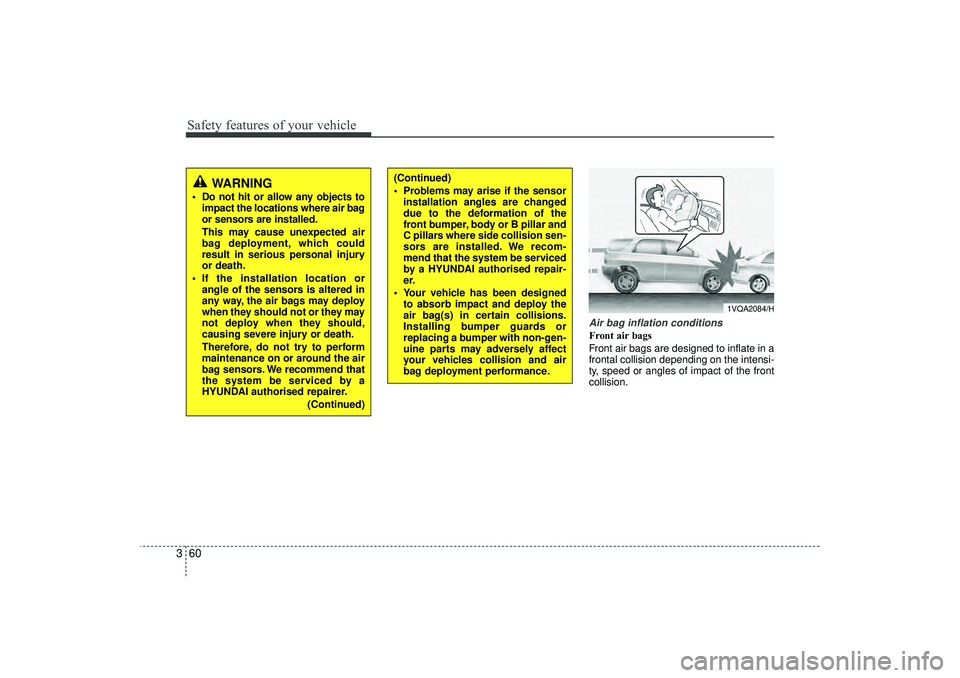
Safety features of your vehicle60
3
Air bag inflation conditionsFront air bags
Front air bags are designed to inflate in a
frontal collision depending on the intensi-
ty, speed or angles of impact of the front
collision.
WARNING
Do not hit or allow any objects to
impact the locations where air bag
or sensors are installed.
This may cause unexpected air
bag deployment, which could
result in serious personal injury
or death.
If the installation location or angle of the sensors is altered in
any way, the air bags may deploy
when they should not or they may
not deploy when they should,
causing severe injury or death.
Therefore, do not try to perform
maintenance on or around the air
bag sensors. We recommend that
the system be serviced by a
HYUNDAI authorised repairer.
(Continued)
(Continued)
Problems may arise if the sensorinstallation angles are changed
due to the deformation of the
front bumper, body or B pillar and
C pillars where side collision sen-
sors are installed. We recom-
mend that the system be serviced
by a HYUNDAI authorised repair-
er.
Your vehicle has been designed to absorb impact and deploy the
air bag(s) in certain collisions.
Installing bumper guards or
replacing a bumper with non-gen-
uine parts may adversely affect
your vehicles collision and air
bag deployment performance.
1VQA2084/H
EL(FL) UK 3.QXP 12/16/2014 8:56 PM Page 60